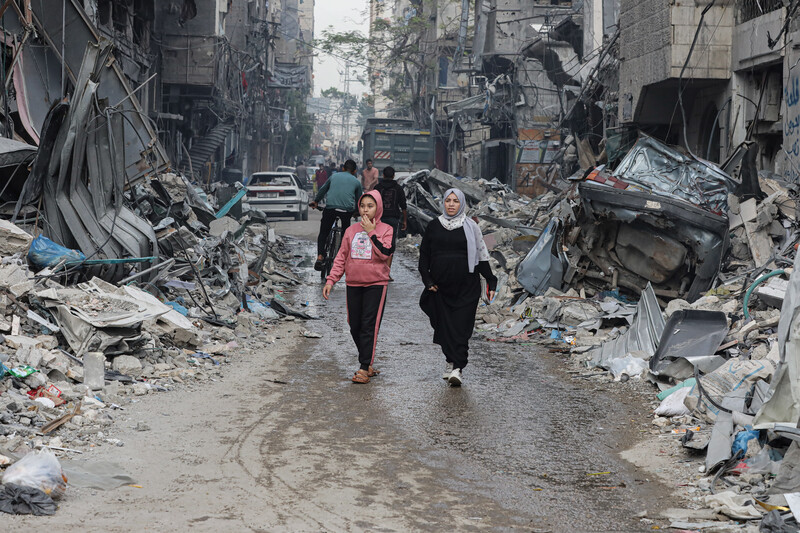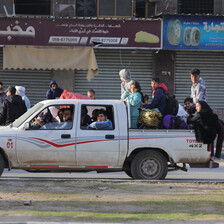The Electronic Intifada 27 November 2023

There is no escape from the destruction in Gaza.
APA imagesThe fear does not leave you during a truce.
On one recent evening, the explosions were so intense that I could not help trembling in terror.
My mother grasped my hands and tried to comfort me. I felt embarrassed that she had to reassure me, now that I am in my late twenties.
Our home was attacked during this war. After the attack, we went back and tried to clean part of it that we thought might be “safe.”
It soon dawned on us that we would not be safe. The realization was heartbreaking.
Although I have depended on my mother for comfort, her own fear is all too apparent.
My mother was born just two years after the Nakba, the 1948 ethnic cleansing of Palestine. Seeing her so terrified in recent days and weeks reminded me that horrors do not discriminate based on age.
Thankfully, some members of our extended family have been able to leave Gaza as they have dual citizenship.
They include my sister-in-law and her children.
She left Gaza in tears. She was worried about my safety.
I urged her to go forth and share our story with the world.
Teasing
Before Israel’s latest war on Gaza, we had been talking about the olive harvest that was supposedly imminent. This is a typical conversation for Gaza families.
Olive harvests involve a lot of work. But that hasn’t stopped me from romanticizing them.
Our conversation involved a little teasing.
My brother recommended that I drop other plans and dedicate myself to gathering olives for a few days. He argued that I should do that as I was consuming a large portion of our family’s olive oil.
Then my father joined in by pointing out that I had spent two and a half years abroad. If I was using a large quantity of olive oil, then I was compensating for that time.
I am often teased.
During the summer, my nieces had poked fun at my limited swimming skills.
They can swim like fish, whereas I struggle to keep up with them.
Before the war, we found pleasure in eating corn, ful (a dish made with fava beans) and knafeh (a pastry) and in quenching our thirst with a barrad (a frozen drink).
Gaza’s cafés would be vibrant throughout the day. In the evening, you would hear the laughter of families relaxing on the beach.
Conversations are different now.
My nieces keep asking me if the sound overhead is an F-16 warplane or a drone.
They ask if buildings that have been destroyed were hit by weapons fired from tanks or from naval vessels.
We have developed our own system of measuring danger.
The sound of a warplane is not in itself considered dangerous. It is only dangerous if it is followed by the sound of an explosion.
Tight-knit community
The main street in Gaza City’s al-Rimal neighborhood used to remind me of M Street in the Georgetown area of Washington. I can’t really explain why but I’ve always found the comparison appealing.
Amid the bustling markets and the traffic, there was a sense in Gaza that everyone knew each other.
One of my nieces once came back from accompanying my dad – her grandfather – on an outing and said: “My grandfather knows everyone. He greeted almost every single person we passed.”
I used to think that being part of a tight-knit community was a blessing. I no longer feel so.
The unfortunate consequence of knowing everyone intimately is that we also bear witness to the losses inflicted on our neighbors, friends and acquaintances.
We all cried when we heard that the journalist Rushdi Sarraj had been killed.
Our hearts ached for Al Jazeera’s Wael al-Dahdouh when we learned that his wife, two of his children and his grandson had been massacred.
Who could remain untouched by the devastating news that the poet Hiba Abu Nada had been killed?
These people are not mere statistics. They are people who had stories.
Stories interwoven with the fabric of our community.
Stories that evoked profound emotions.
Stories of shared grief.
Every time I learned that a specific family had been wiped out, I immediately texted a friend or a colleague who was related to the family in question.
Among the many thousands of people killed was the nephrologist Dr. Hammam al-Louh. He had been treating my brother.
Although I had never met Hammam, I often accompanied my brother when he was going to the hospital for dialysis.
Hammam and his family were massacred when their home in Gaza City was attacked.
They remained under the rubble for a considerable period of time as a strict curfew was imposed on the city. It took quite a while before civil defense personnel could retrieve their bodies.
Hammam had worked in both Gaza City’s al-Shifa hospital and in al-Aqsa Martyrs hospital, central Gaza.
When Hammam was killed, his patients felt as if they had lost a member of their own family.
I asked my brother why. He explained that Hammam was kind and took his time during consultations, even if that meant he would have to see fewer patients.
He gave each patient the attention they needed.
“He treated every patient with the utmost respect,” my brother said. “I was not surprised at how he refused to leave his patients when Israel ordered people in the northern part of Gaza to move south.”
Joe Biden, the US president, has questioned the official death toll from the Palestinian health ministry in Gaza. Biden evidently does not want Palestinians to be properly accounted for.
The Gaza you see on your TV screens or in social media videos is not the Gaza I grew up in.
The once lively streets have turned somber. They are painted with shades of gray and red.
The grayness is not due to fog or the absence of sunlight. It is the result of all the rubble that remains on the ground after countless homes and other buildings were leveled.
The red comes from the blood of people massacred.
You keep imagining all your loved ones in these colors.
Gray and red.
Ghada Abed is a journalist based in Gaza.





